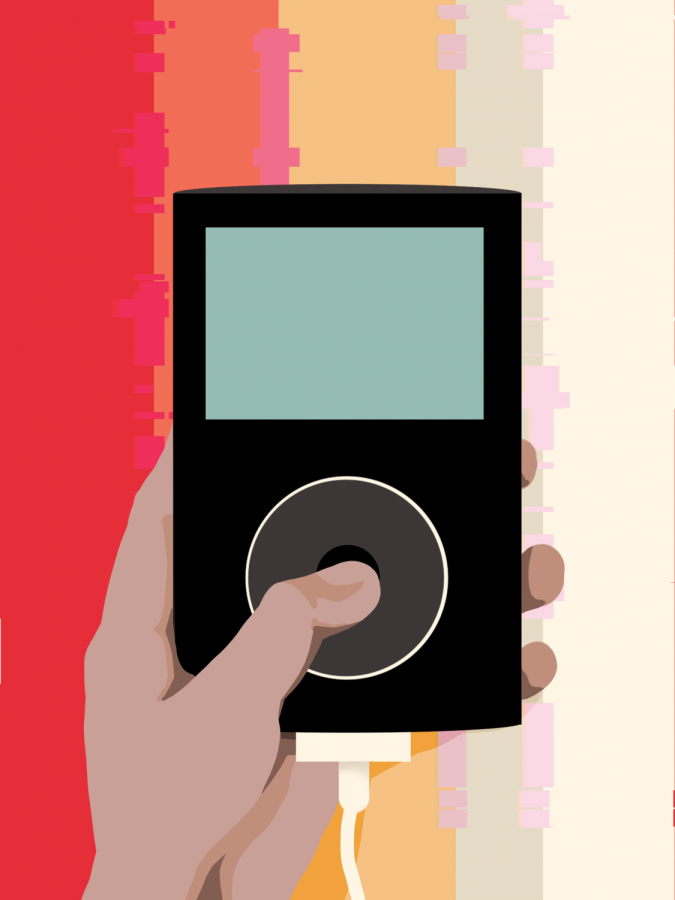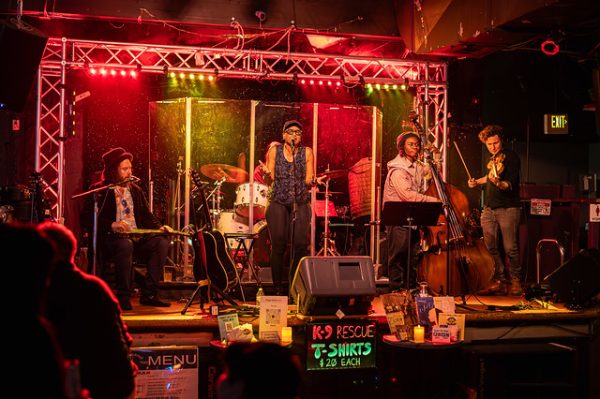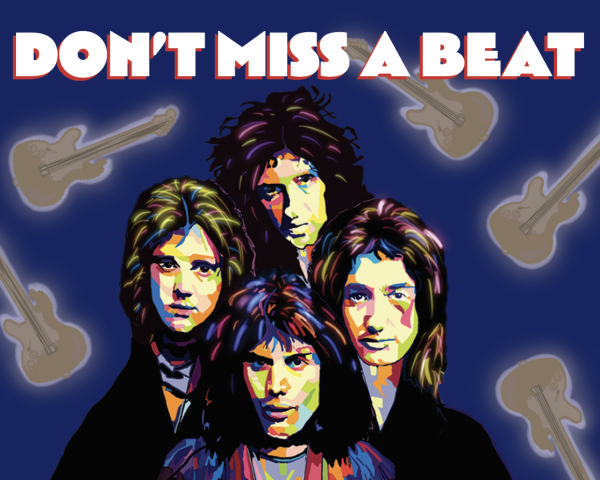Shuffling Through the Ages
From old to new: the evolution of listening to music
On a typical morning, Junior Alex Yan hastily grabs his phone from his desk as he rushes out of his house to make it to school on time. He shoves his AirPods into his ears as he opens Spotify and shuffles his favorite album, which begins playing in a matter of seconds. He hops onto his bike and rushes to school.
Whether listening to music on a phone, computer, through the radio, or with vinyl, music makes its way into everyone’s lives, including Paly history teacher Eric Blooms. Bloom believes that music is something that helps him get through the day. “[Music] just helps my blood go in the morning, and I’m working at my computer and just bouncing around a little bit,” Bloom said. “I like what the music does for me.”
Like many other people, Bloom used iTunes, CDs, and records to listen to music before streaming services existed. Even though some may consider this to be more of a hassle, Bloom recognizes the quality of listening to music in older ways. “I like the idea of the physicalness of turntables and LPs,” Bloom said. “It’s a needle on ridges producing sound, it’s kind of cool.”
Instead of scrolling on a phone screen, having something to grasp and physically hold on to adds to the experience of picking out what music to listen to with friends. Each individual’s music collection was meticulously crafted because music was so expensive, so there was considerable choice involved. Therefore, music collections were frequently full of gems of personality and memories. “When you have your records or your CDs, you’re physically going through things, and then you’re like, ‘oh, yeah, I remember this,’” Bloom said. “We have friends that have 1000s of records, and so it’s interesting when you go there like, oh, yeah, this and this and this, and then it’s just like, oh, I never played this one. This is the, like, collectible edition or whatever.”
Not only did older music formats offer excitement and conversation when choosing what to play, the experience of finding new music was more collaborative. “It was a planned activity,” elementary school music teacher and Paly cheer coach Lea Santini said. “I was on the cusp of cassette/CDs, and we went to [stores] and everyone looked at a CD collection and ‘Who’s your favorite? Who are you going to get today? Who can we swap with?’ so that’s kind of this culture that I wish would come back.”
Besides the act of listening to music, in the past, music was an activity that brought people together. Because there wasn’t immediate free access to millions of songs, high schoolers went to great lengths to find the music they wanted. “When you’re in high school, the cool thing to do [was] go rip all the music off the internet,” Santini said. “Then you [would] burn your CD, and you [would] make playlists for your friends.”
Junior Dora Pang believes that the advantages of listening to music in older ways still hold true today. “There’s a difference in sound quality between the stuff on your phone and your vinyl,” Pang said.
Despite shifting to streaming services with a broader variety of music at everyone’s fingertips, developing a distinct music taste is still a journey. Although some of the physical aspects may be removed, music taste can still be tied to memories and relationships. Freshman Abbie Karel loves listening to music and credits her parents for the formation of her music taste. “When I was growing up, my dad used to play a lot of music, or my mom would always listen to 80s music and stuff like that,” Karel said. “That’s why I like [music] a lot.”
Even though much of the music she listens to comes from these external influences like family and friends, social media still plays a big role in her music taste. “A bunch of songs I like now I discovered on social media,” Karel said. “I just recently discovered [a band] because of something on Tik Tok, but now I listen to all their songs.”

Similar to Karel, junior Damian Perez also believes that the advancements in technology have contributed to his music taste. “I think if it wasn’t for me having the internet on my side, I would not have listened to as much music as I do now,” Perez said.
Perez also credits social media for the rise of music not typically seen in mainstream media. “I think social media has affected people’s tastes, especially more pop-type stuff,” Perez said. “I’ve also noticed that J-pop or K-pop has become more of a mainstream type thing recently and I primarily would put that towards Tik Tok or Instagram to make it more popular nowadays.”
Along with the rise of finding music through social media, nowadays, the use of streaming services has also risen because of their endless features and easy use. One of the most popular streaming services amongst all age groups is Spotify. One thing Spotify is most popular for is its pre-made playlists and new music discovery capabilities. “I feel like sometimes [the premade playlists] are helpful if you are trying to get into a genre,” Pang said. For example, I wanted to start listening to folk music and I think the playlist genres from Spotify actually have a lot of good basic recommendations.”
Perez is also a big Spotify user and loves how easy it is to use on different devices. “There’s just so much more versatility,” Perez said. “You could have Spotify on your computer and phone and also [on] your Xbox.”
Streaming services, like Spotify, are also liked by music lovers who grew up listening to music in older ways. Bloom is one of many users who take advantage of all the features that they offer. “They put together these daily mixes for me, and release radar so that I will occasionally listen to music that I never would listen to because it’s just what’s being released this week,” Bloom said.
Even though the rise of listening to music in new ways has exceeded the popularity of listening in old ways, some teens have shown interest in listening to music through CDs, cassettes and vinyl. “I think the reason why I listen to vinyl is because there’s some tracks that, for some reason, they’re not on streaming services or anything like that,” Perez said. “That’s the reason why [I] mostly like vinyl, but also having that older, kind of more mechanical feel to it.”
Similarly, Karel also thinks that using old ways of music listening gives an entirely different experience compared to modern streaming services. “[Using a record player] just makes [listening to music] more special,” Karel said.
However, some modern music listeners think that streaming services are much more straightforward, and have never given a second thought to experiencing music in older ways. “There’s no point in using a record player unless you want to be quirky and aesthetic,” Junior Alex Yan said. “I understand, record players look super dope, and they’re retro, but I’m just a practical person.”

With the rise of listening to music through modern technology, many music fans agree that society has come to value our music less in recent years. Some music fans feel that they do not really experience the music anymore, instead, they are just listening to it. “I find I’m guilty of not even knowing what the covers even look like anymore,” Santini said. “[I] just play the song because I like it, but I think you do miss the artwork like what they’re putting into the album.”
Likewise, Bloom also believes that the concept of an album has completely changed. “The album is a collection of songs put together on purpose,” Bloom said. “Everything on [the album] is there for a reason. It’s not just like, oh, let’s just throw these six songs together.”
He believes that because we’ve changed the way we listen to albums, they lose the effect that the artist intended the album to have. “On an LP, you technically could jump around, but it’s just really hard, so the idea of listening to something from beginning to end in the way that it was put together, I think, has some value,” Bloom said.
Even students can recognize the loss of value that happens from only listening to music on streaming services. “[Using streaming services] somehow made us appreciate music less,” Karel said.
Even though there are countless ways to enjoy and listen to music, each way brings a unique experience for the listener. Although we may not all agree on the “best” way to listen to music, and listening methods might change, music still has the power to bring people together. “Listening to music is also a community thing rather than just a personal taste thing,” Pang said. “People talk about music, people go to concerts together, that kind of stuff, it’s a bigger thing.”
Art by Kellyn Scheel

2021-2022 - Staff Writer
2022-2023 - Managing Editor
I joined C Mag because it seems like an amazing opportunity to be able to be creative and write...

2021-2022 - Staff Writer
2022-2023 - Business Manager
I joined C mag because art has always been a big part of my life. I always loved looking through...







